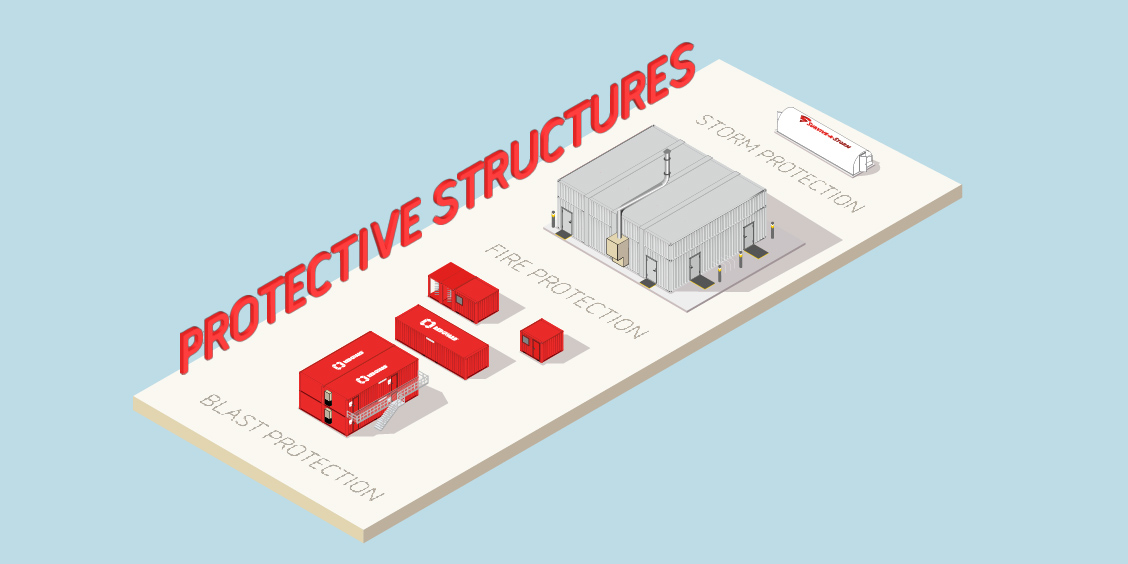Articles | Types of Buildings | Threat Protection Types
Comparing Protective Buildings, Blast Protection and Hazard Protection


When it comes to protection in the form of buildings, there are a few levels of protection that can be observed. For this blog post, we will focus on three building types: general protective structures, buildings that offer blast protection, and buildings that offer hazard protection.
What Are Protective Structures?
A protective structure might be any building meant to protect its occupants or contents from some form of threat. RedGuard, and several of its brands, sell buildings that are considered protective structures.
The differences in these structures are in what they are intended to protect against and the level of protection required. The word “protective” is a general word that encompasses many things. So, the two other types of buildings we’ll talk about are also protective structures. A blast-resistant building is a protective structure, and so is a building designed for hazard class protection.
But when it comes to a general protective structure, you might only need a rugged building outside of anything designed for a specific hazard class. That could be as simple as modular container storage or mobile offices.
We got our start as “ABox4U,” which later became our SiteBox brand. While they are not blast-proof, the brand has rugged container storage options and mobile offices perfect for areas outside of hazard zones that still require durable and robust modules for storage or small offices.
Unlike RedGuard, our SiteBox mobile offices start as containers and are converted to serve simple office needs. They are built to last on worksites where a standard office trailer may not do the job.
The company now offers several pre-designed layouts - customizations to a standard container - for those who need a robust module that’s more than just storage or an office.
Another type of protective structure is designed for storm protection. Survive-A-Storm, known in the industry as “America’s Tornado Shelter Provider,” is now part of RedGuard. The company sells both residential and commercial severe storm shelters. They’re available directly from our manufacturing facility and through several retail DIY stores. The shelters are tested at Texas Tech Wind Institute, rated for F5 tornados, and certified through the National Storm Shelter Association. It’s a brand that was easy to embrace for the leaders at RedGuard and the company’s focus on safety.
Blast Resistance Is More Than Just a Protective Structure
For RedGuard, protective structures are blast-resistant buildings. The LeaseFleet brand is the country’s largest fleet of leasable blast-resistant buildings, and SafetySuite is a premier line of fully custom blast-resistant modules. Somewhere in the middle is RediSuite, suite-quality pre-engineered blast-resistant buildings that come in several multi-functional, standardized layouts.
The buildings are intended to protect people and assets in hazardous areas from the threat of explosion. Because the leaders at RedGuard believe that protecting life is of utmost importance, the company sells only steel blast-resistant buildings rated for a medium or low response, representing only medium or low damage in an explosion.
How Hazard Protection Differs from Blast-Protection
As terminology goes, hazard protection is not really an official term of any kind, but it is used to reference the types of hazards encountered in various classified areas.
One of our related brands, Specialized Services RedGuard, has written about what hazardous locations are and the differences between division and zone ratings as they relate to hazardous areas on their blog. The brand specializes in modular offshore buildings. All of them would be considered protective structures, and many of them would be considered hazard protection too.
At RedGuard, hazard protection starts with our blast-resistant buildings. While some companies just sell “hazard protection,” with a single design that combines multiple hazards, like fire and blast protection, we take a different approach.
We understand that there are some zones that only require blast protection. Putting a building in that area meant to address multiple hazards could mean that you’re spending more than you need to.
That’s why we take a different approach, starting with blast protection, as that is our area of expertise. You can always be assured that you and your team will be safe from the danger of an explosion in a RedGuard building. From that point, we meet with customers to determine the scope of their needs. This might start with a Quantitative Risk Assessment or a Facility Siting Study.
Based on that determination, needs may dictate that the building should also have protection from a jet or pool fire, toxic gases, or it may be designated as a complete shelter-in-place facility. Any level of hazard protection can be added to RedGuard’s steel, modular blast-resistant building, without the need to purchase a building that protects at a higher level and comes with a heftier price tag.
In addition, if you start with modular blast protection, levels of protection from other hazards can be added later, as the needs of the hazard zone or area change. The following are some examples of hazard protections that can be added to a steel modular blast-resistant building.
Protection from a Jet or Pool Fire
For a jet or pool fire, the approach that RedGuard takes is an intumescent coating, like Chartek. The coatings, applied to a steel blast-resistant building, have had great results, and RedGuard tested this in its most recent blast and fire test just to be sure.
For testing purposes, RedGuard leaders posed the question of what would happen with a vapor cloud explosion that was followed by a jet fire (in the same event).
In their tests, they applied various coatings of Chartek to an 8-foot by 20-foot, 8-psi-rated blast-resistant module (BRM) and then exposed that BRM to a 7.3-psi free-field blast at 193 feet. After the explosion, the intumescent coating was inspected and showed no damage. It was then exposed to a fire of more than 2,000 degrees Fahrenheit for 30 minutes to test the coating even further. Again, the coating withstood the fire test and performed as well as it would have with no explosion.
Protection from Toxic Gas Release
Some areas, again determined by an FSS or a QRA, may require protection from toxic or flammable gases. It could be that a dangerous gas is present, or there could be a danger due to process leaks. In these instances, gas detection is added to warn occupants of gas release or the proximity of dangerous gas. (They may also employ measures like personal gas detectors and other alarms.)
For toxic gas danger, a RedGuard building can be installed with positive pressure, supplied by a fresh-air intake to the HVAC system. That fresh air intake is often elevated to a height above possible gas cloud formation. The buildings would have gas detection in the fresh-air intake and on the exterior of the building. Gas detection can be incorporated into building alarms, automated damper control, and HVAC shutdown and linked to plant emergency notification systems.
If the danger comes from a flammable gas cloud, RedGuard buildings are provided with similar positive-pressure arrangements and explosion-proof exterior electrical accessories as required by the National Electric Code/NFPA 70.
Shelter from Storm danger
Storms can produce dangerous winds or tornadoes at any time of day. All modular buildings in hazardous locations need to meet local requirements for wind, snow, seismic, and other environmental loads. While the ability to withstand a blast would logically lead you to believe that a building will easily withstand wind loads for any place worldwide, wind and other environmental loads still need to be calculated, confirmed, and stamped by a qualified professional engineer. RedGuard has impact-tested its BRMs by firing a projectile from an air cannon, per ICC 500. And, if that’s not enough, we also offer both commercial and residential storm shelters through our Survive-A-Storm brand, as mentioned above.
Other protections that could be considered hazard protection are for security threats, like ballistic resistance and protection from forced entry. At RedGuard, those are found under the umbrella of our CoverSix brand, which is highly regarded as a leader in providing government and military customers with a wide variety of structures for protection and security at any threat level.
As you can tell, there are many options when it comes to protective structures. RedGuard (and its associated brands) are proud to offer extensive coverage for a wide variety of needs. To talk about your needs, reach out to us and get the conversation started:
- CoverSix: focuses on government and military customers with a wide variety of structures for protection and security at any threat level. These structures feature threat mitigation such as blast resistance, ballistic resistance and/or storm protection, as well as custom-outfitted ISO containers to be used as portable storage facilities and mobile office locations.
- RedGuard: builds modular solutions that protect lives and assets. The leading supplier of blast-resistant buildings and modular safe spaces, through brands like LeaseFleet, RediSuite, and SafetySuite.
- SiteBox: the go-to storage solution for companies throughout the Midwest and the Carolinas. SiteBox Storage offers the most responsive and reliable customer service, with unmatched logistics and one of the region’s largest fleets of portable storage units and onsite offices.
- Specialist Services RedGuard: this Houston-based joint venture company formed by Specialist Services and RedGuard, addresses the demand in the Western hemisphere’s oil and gas industry for onshore and offshore modular buildings, technical buildings, and accommodation modules, as well as service, maintenance, and parts. Whether your needs are to address safety, choose the appropriate living quarters or technical modules, or somewhere in between, Specialist Services RedGuard has the assets and expertise to serve you.
- Survive-A-Storm: The leading producer of prefabricated steel underground and above-ground tornado shelters, with direct and retail distribution, for commercial and residential use. Shelters are rated for F5 level protection, tested at the Texas Tech Wind Institute, and certified for use by the National Storm Shelter Association.
Carreen Gibbons
Carreen Gibbons is the Communications Specialist at RedGuard. With a natural curiosity toward technical subjects and a love of learning new things, she writes content for the SiteBox Storage and RedGuard websites and spends her days learning new things about the industries that the companies serve.

